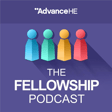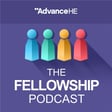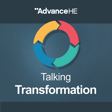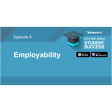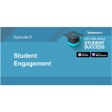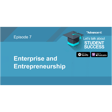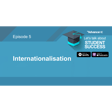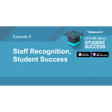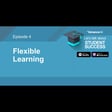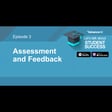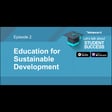Become a Creator today!Start creating today - Share your story with the world!
Start for free
00:00:00
00:00:01

Exploring Fellowship - Descriptor 2
This month Louise, Raj and Marita discuss all things to do with Fellowship category Fellow, which aligns with Descriptor 2 of the PSF 2023. This is the most commonly awarded category of Fellow around the world, with a community of over 129,000.
The team cover every aspect of the category, including what makes a successful application, who it is suitable for, and some top tips for prospective applicants.
Transcript
Introduction and Hosts
00:00:13
Speaker
Hello and welcome to episode five of our Fellowship podcast series. um It's hello from me, Louise Lumsden, Head of Fellowships Teaching, and I'm delighted to be joined again by Raj.
00:00:25
Speaker
Hello, it's Raj Thima here, Fellowship and Awards Advisor at Advance AG. And Marita. Hello, Marita Grimwood, Senior Advisor for Teaching Fellowships. ah Really nice to see you, Raj and Marita.
00:00:38
Speaker
And as a reminder, you can get involved with our Fellowship Podcast series via the hashtag HAHE Fellowship Podcast. So here we are again.
Episode Focus: Descriptor 2
00:00:49
Speaker
um in our last episode, we focused on Principal Fellow and explored the key characteristics of the category. That was Descriptor 4 of the Professional Standards Framework for Teaching and Supporting Learning.
00:01:01
Speaker
um We had a really good session, didn't we? We were joined by our special guest, Gemma Whitton and Marita, you expertly led us through the key requirements. We were looking at the impact and the importance of communities and networks. um For this session, we're going to focus on Descriptor 2.
00:01:21
Speaker
And Descriptor 2 aligns with Advanced HE Recognition as fellow. So as a reminder, from page eight of the Professional Standards Framework, Descriptor 2 is suitable for individuals whose practice with learners has breadth and depth, enabling them to evidence all dimensions.
Understanding Descriptor 2
00:01:43
Speaker
And then there are three criteria that an applicant will be um applying and writing their submission against. So I think it's fair to say, isn't it, that the majority of fellowships awarded are for this category.
00:02:00
Speaker
And we currently have around 129,000 fellows. So this category of fellowship is by far the largest. Most fellows are awarded through accredited institutional programmes and schemes, um probably mainly programmes such as postgraduate certificates.
00:02:21
Speaker
um But also for direct applications, so that's those applications made direct to Advance HE, this category of fellow fellowship is also um our biggest and we see more applications for Descriptor 2 each year than for any other category.
00:02:39
Speaker
So hopefully that sets the scene and whether you are thinking about making an application, you are just in the process of applying for this category or you are mentoring, a colleague, um then Raj and Marita, where shall we start um to um look at Descriptor 2 for fellowship?
00:02:59
Speaker
I'm happy to to start and see how we go. yeah Yeah, and Descriptor 2 of the Professional Standards Framework, I mean, it's along with Descriptor 1 is one of the longstanding categories of fellowship that we've had.
00:03:13
Speaker
you think about its initiation from the 2006 framework and the various versions since then 2011 and now 2023. twenty three And if we think about this category in the round and where and how it is recognised and reflected in institutions,
00:03:32
Speaker
when you have a big proportion of workforce that have responsibilities substantive responsibilities in teaching supporting learning the administration of learning research around teaching and learning coinciding with their subject expertise or their discipline expertise or their service expertise and that's applied as part of their roles and responsibilities in the main this category of fellowship is for those types of people so for people who are undertaking a substantive amount of work directly with learners in a higher education context wherever that might be um situated um and undertaking that responsibility to deliver and support the best quality student experience as possible and the PSF and D2 is designed to enable applicants or individuals to both develop their practice
00:04:26
Speaker
and across those different
Dimensions of Descriptor 2
00:04:28
Speaker
dimensions. And if we just clarify that in terms of what D2 is, so the D2, Louise outlined helpfully the criteria D21, D22, and D23.
00:04:37
Speaker
And if we look beneath that, essentially what that is, is a set of dimensions depicted by five professional values, five core knowledge. and five areas of activity.
00:04:49
Speaker
So areas of activity is what people do, the knowledge is the the knowledge that people have in order to demonstrate how they carry out their activities, and the values work with the knowledge to underpin the activities that are carried out. And it's through that kind of cyclical way of both engaging and developing and implementing practice meaningfully and effectively with learners that descriptor too is ultimately then demonstrated at a relevant point.
00:05:13
Speaker
So the way that institutions and individuals would use that is really vital and it allows individuals within ah ah space of teaching and learning who work in that way to to have that practice recognised.
00:05:26
Speaker
um And that's such a valuable thing for anyone to be able to do a given point in time. And even though we've mentioned that quite often this is encapsulated within things like taught programs like PG certs, et cetera, et cetera.
00:05:39
Speaker
It's also really helpful ongoing CPD for people as well, because it doesn't have just stop achieving a fellowship isn't the end of anything. It's actually sometimes the beginning of a journey once practice has been consolidated because teaching and the learning evolves, you know, new methods and approaches occur.
00:05:57
Speaker
We might have the onsite of AI to consider and how to demonstrate that in our practice with learners. And applicants are continually using this criteria to engage with fellowship and demonstrate the requirements of fellowship as well as enhance ongoing CPD.
00:06:11
Speaker
So the category is really for people who are in mainstream roles in teaching and learning and is applicable to all sorts of different contexts. So not only is it for kind of traditional academic staff, it's for professional services, it's for industry staff, it's for colleagues working in healthcare, health professional services, and that opportunity to really consolidate practices is a vital part. So think those are the kind of key elements of what Descripted 2 is and who it's for and then the ways which people might consider the relevance of that category for them.
00:06:44
Speaker
Yeah, definitely. Thank you for outlining and setting the scene, Raj. And I think, you know, Just a couple of things before I know Marita comes in. um You outlined how the framework is used and it's about building that application because the dimensions are underpinning and, you know, an applicant would evidence um the descriptor criteria using the dimensions and it's how you use the professional standards framework as a tool for both that initial, that ongoing and professional development, isn't it, and how the the framework will
00:07:19
Speaker
support that. And, um you know, I'm sure we'll come on to um the the nature of practice um in a moment. But Marita, think, you know, just explaining, you know, Raj has outlined who might be eligible, who who might be working within this category, but the description of the descriptor and that breadth and depth of practice, would you be able to say me more about
Depth and Breadth in Descriptor 2
00:07:47
Speaker
that?
00:07:47
Speaker
Yeah, thanks, Louise. That's a great question because bread breadth and depth is really a key phrase for thinking about fellowship, descriptor too. I think it's very helpful to think about talking to um a fellow and an associate fellow here and what we would expect to hear from them. So if I am talking to somebody who's an associate fellow who's got D1 recognition, and I'm asking them about their teaching.
00:08:15
Speaker
I expect them to be very professional because they've had to talk about how they respect individual learners and they've had to show that they use evidence-informed approaches of some kind and evaluate their practice.
00:08:31
Speaker
but they might have quite a narrow range of experience. For example, it might be a postgraduate student who runs seminar classes or demonstration for la students.
00:08:44
Speaker
It might be somebody working in a library who runs workshops for research students, for example, um using research skills and tools.
00:08:55
Speaker
um So their experience of teaching might be quite narrow. If I speak to fellow, somebody we've recognised at D2, and if we could pick any area of activity, they would have different examples for working with different students.
00:09:14
Speaker
are maybe first year and third year students, maybe undergraduate and postgraduate students, or very different first and second year modules.
00:09:26
Speaker
They'd be able to talk in more general terms about their approaches, um which approaches are effective with particular groups and why. And they would have enough experience to be taking ownership I think of their teaching of some of that decision making being able to being able to think about think about the different the different approaches that they're using so yes so it's that range range of different experience exactly and also Marita you talked about ownership and I think it's accountability and responsibilities isn't it and
00:10:06
Speaker
you know, Rad, you picked up on that as well. It's about the nature of the practice and what are you accountable for? I think a really good example would be um area of activity one a one where it says design and plan learning activities and or programmes.
00:10:23
Speaker
and Whereas somebody who's an associate fellow might be designing particular activities, but not really have responsibility for a whole module or a programme.
00:10:34
Speaker
For fellowship, we're much more likely to see that level of responsibility. Yeah, I was just going to add to that really is given the myriad of roles and responsibilities that exist in a higher education context, you know, what we're quite clear on is that there's no kind of prescriptive role that defines what D2 is or what Descriptor 2 is fellowship.
Roles and Responsibilities in Descriptor 2
00:11:00
Speaker
It is whether somebody is practicing at D2 category and, you know, institution both institutions that are accredited and Advance HE produce a lot of guidance around this space with numerous extracts and excerpts, et cetera, et cetera, including the guide two for each category and particularly for d two That differentiation is absolutely a really helpful way.
00:11:21
Speaker
And if you know if you're an applicant listening to this and you're unsure, ah you know first stage would be to do ah the fellowship category tool. And that fellowship category tool is really and a great way of indicating whether you're undertaking A, the appropriate activities aligned with descriptive two and then B, the extent to which that practice is effective and inclusive at the required breadth and depth that's needed for D2. Because sometimes that can cause a bit of confusion or it may be actually that people are in between So they've achieved E1 or they're kind of well on their way with D1. And actually they're continuing to involve their practice.
00:11:53
Speaker
They're taking on greater responsibilities in their respective organization, or institution or HE context and actually go on to become that kind of autonomous organization. lecturer or professional service tutor or whatever and that then enables them to be equipped with both doing the practice at d2 and then at the appropriate point being able to demonstrate the requirements and i think i just want to touch on the the bit about the demonstration of the requirements as well because professional recognition at d2 is not only about doing the job it's about doing the job well
00:12:25
Speaker
it about knowing that you do the job and that the learners and this subject and discipline or the service that's being taught is actually making a meaningful difference to the achievement, the progression, the outcomes of of what learners are achieving and and how that's known through the applicant.
00:12:41
Speaker
And a typical way of of doing that or seeing that is ah kind of through a cyclical way ah of evaluation and practice. So it's not enough, for example, just to do a season or kind of single iteration of a delivery of of teaching, for example, because there's not going to be the capacity within that to be evaluated and then made improvements.
00:13:01
Speaker
Because as we know, and I think as everyone listening will know, that teaching and learning is is something that's developed as as a quality that's not really you know intended as something where participants or applicants can actually make a difference and knowing what that evaluation is and then how that evaluation is used to change a service to change a course or module to make a difference based on student feedback or quality systems and then implementing that to see the benefit of learners is often a really good way to show that
00:13:32
Speaker
things have gone gone on beyond and better than what's happened before at the appropriate breadth and depth for D2 as well and I think that's a really um important aspect particularly thinking about I think I must have seen thousands of applications over the years now and but you know a common thing that we always, always see is that we don't really know how how much of a difference a bit of practice has made. So say, for example, in a two um discussion about different approaches in teaching and learning are provided. There's a rationale, there's some underpinning, but then we don't really know what difference it's made or why something has been changed or how we know it makes a difference for learners as well.
00:14:11
Speaker
And that effectiveness is a really um kind of key part of the current PSF 2023 and Descriptor 2 that's re-central in demonstrating
Structuring Descriptor 2 Applications
00:14:21
Speaker
the requirements so that once people have that award they know that not only are they doing the job but they're doing it well and other stakeholders will know that as well in terms of institutions and things like that so that's a really important part i feel it it is raj and that sort of brings me back and reminds me of the podcast we did about the simple reflective model and in the i think it's probably a good point to now say that making an application direct to advance he
00:14:49
Speaker
ah for fellowship, an application is a written application, 3,000 words, and that's written ah under all of the five areas of activity. um And we're we're bringing up the areas of activity during our conversations. We've already mentioned A1 and A2, which is great.
00:15:06
Speaker
And also we spoke and we seem to speak a lot about Core Knowledge K3, which is the effectiveness. And you're absolutely right. um There's a really fantastic phrase on page 10 of the Applicant Guidance for fellow Fellowship um applicant guidance and it really sets out um for the, ah ah you know, an example of evidence to say what the rationale was that, why it all came about.
00:15:30
Speaker
um Why, as you said, Raj, why are any changes? What's the evidence base? Remembering V3, the evidence base war and for the the way that you do something. And then really telling that story about what happened and what impact it had. What difference did it make to to student learning? So, you know, look up that phrase on page 10. It's really, really helpful and just helps to, because I think writing an application for fellow across the 3000 words, it's about structure, isn't it?
00:16:00
Speaker
it's about structuring those examples. um I don't know what you both think about how to go about starting to write an application. I think this is a useful place to bring in reflective model that we've explored elsewhere, isn't it, which is on page 15 of the guidance. it's and um it it's but It identifies a that what what you did, why you did it, how you did it, and how you evaluated and what changes you made, as as you as you've said, Louise.
00:16:35
Speaker
And I think starting to map out what you've done is a very good good thing to do. then you can start to think about what you have to say in addition to that about the how and the why and the evaluation and the changes.
00:16:52
Speaker
And once you do that, you'll start to see which of these examples you can talk about in sufficient depth to really evidence the areas I activity and the core knowledge and the values. And you will realise that there are some that might be perfectly good examples, but they would not really add anything to your application.
00:17:16
Speaker
So i I think that's a very good way to to start. I think that's a really nice way of of helping an individual to navigate the framework.
00:17:26
Speaker
think particularly on first view, the framework might not it won't be familiar at all um in terms of the descriptor too, the dimensions, et cetera. And it's kind of what are these descriptors, what are the dimensions, et cetera, et cetera.
00:17:39
Speaker
And the familiarity of that as well, you know in terms of the language and the semantics that are used to explain that, but what the PSF and Descriptor 2 does particularly is provide that common language around teaching and learning. And then the meaning behind that is contextualized for the applicant.
00:17:54
Speaker
And so it's going back to that autonomy thing where it's the ownership where actually the the the the psf and the descriptor is owned by the individual is owned by the person applying and the descriptor represents them or represents part of them and who they are in terms of their identity as a higher education professional and their ability to demonstrate those requirements i think another way of thinking about it is if that is too difficult to start off with can kind of see as a bit of a jigsaw where you've got the different components of teaching practice
00:18:26
Speaker
which are essentially the dimensions, and you've got the separate part, you've got the pack. You're then piecing them together that suits your particular context. So the picture will be different for every single individual, but that picture will be complete through the duration and development of the creation of the evidence and the successful demonstration of D2.
00:18:43
Speaker
And that's the wonderful thing about it, because each picture is is but representative of the context of the individual and the way they piece together. so for example, the way a two would link with ah say v3 and then link with one of the knowledge dimensions will be totally unique to the individual and there are patterns and trends in how the dimensions might come together we exemplify those in the guidance but actually when the individual takes the unique approach to say okay what is it that i'm doing my practice what knowledge do i have to apply that and what values am i using to underpin what i do it then comes to life and and that's the beauty of of of that as well
00:19:20
Speaker
And that unlocks a lot of the thinking, I think, when we' we're talking to applicants, certainly when I've talked to applicants over many, many years, it's kind of unlocking that potential and what things mean and actually kind of connecting those different aspects and facets together.
00:19:34
Speaker
and And there's absolutely a structure. to the whole thing, you know, 3000 words in a direct application or equivalent in an assessment, an institutional program or scheme isn' is going to be defined by parameters, whatever those parameters are in a written or presentation or audio format.
00:19:51
Speaker
and And that means that individuals can't provide or write about or talk about everything that they've done in their practice, they a need to be selective and then B, need to then think about the depth and breadth of the articulation to explain the effectiveness and the inclusive practice linked to that as well.
00:20:08
Speaker
I just think of so many applications I've seen that have a tendency sometimes to list things or to provide a CV or to try and cram so many different examples that it becomes effectively a kind of a list of responsibilities which is wonderful in terms of the accolades that individuals achieve but won't meet requirements of Descriptor 2 because what Descriptor 2 is asking for is just pulling that back and asking people to reflect and what their applicant is demonstrating and what reviewers are looking for is is clarity around the decision making of the individual and how they think and how they operate and how they teach and how do they know it works.
00:20:48
Speaker
And essentially, once that's understood, that can really help applicants to navigate the requirements and be OK with actually parking lots of other things that they might be doing in their in their life and in their world and and for the purposes of meeting the requirements the focus on that depth and breadth of a selective range of examples will absolutely meet requirements and when done effectively and meaningfully i think you're absolutely right and you know Marita you started um this this bit of our conversation about thinking about the planning and thinking about the the nature of the examples and
00:21:21
Speaker
you know it's As Raj said, it's not about writing absolutely everything you do. It's being selective to be able to ah reflect. Because if you think about it, 3,000 words written under five areas of activity, it's giving you about 600 words, isn't it? So it's not a lot.
00:21:38
Speaker
So you know writing has to be succinct, but to include all the required elements. Yeah. Absolutely. so after you've identified those promising areas of your work and experience, which you think you could write about, you need to start thinking about them under those headings of the different areas of activity.
Effective Application Writing
00:22:00
Speaker
And you need to make sure that you've got a very sound understanding of those areas of activity. And I can't recommend highly enough the Fellowship Guide to the Dimensions, which takes each of these areas of activity one by one and gives such clear, detailed guidance and examples um and prompt questions to help you reflect but it's well worth engaging with this at an early stage because if you don't if you go into writing and planning those sections without a very firm understanding of them there's a risk that your examples aren't the best evidence for the individual areas of activity and that means you can end up over evidencing some areas and under evidencing others and we get feedback from panels saying things like well
00:22:53
Speaker
Some of the material in A4 is really more suitable for a two or um something like that. So that that's something to really build into your application process.
00:23:06
Speaker
Definitely. And you mentioned the prompt questions. Those prompt questions are absolutely brilliant, aren't they? Because, you know, you could use it if you're a mentor of and you're working with your mentee and those questions are the starting point. They really get to the heart of practice and what an individual might be doing and That sort of, you know, those moments of inspiration, you know, when when we are there and we've got our guidance, we all need a bit of inspiration, don't we? And sometimes just having, knowing where to look and just sitting and thinking about those questions, pondering on them, you know, will hopefully highlight other areas of practice that, you know, you'd you'd really like to um include to make the best claim possible um for your application for fellowships.
00:23:52
Speaker
um I just wanted to sort of, we're almost coming to the end of our um Descriptor 2 episode, but I'm just wondering, um have you got any sort of hints or tips or is there anything that you've noticed about this category?
Common Pitfalls and Advice
00:24:09
Speaker
um Is there any dimension in particular, for example, that you see um often people might fall into a trap and, you know, I, I could start, I've got a couple that I could start off, K5.
00:24:23
Speaker
I often see where k five the requirements for quality assurance and enhancement and their implications for practice might not be quite strongly. But what I want to ask you about really as well, while you're thinking about a dimension, is what do you think of area of activity A5?
00:24:40
Speaker
That's enhanced practice through own continuing professional development. And would you like to sort of make any comments about that particular dimension? Well, what we tend to see with this dimension is that people can give examples of where they have engaged in professional development.
00:25:01
Speaker
Where they might be less successful is in showing how this has had an impact on their practice and how this has enhanced the experience for learners and how it's made their teaching or supportive learning more effective.
00:25:18
Speaker
So that is that's that that's the dimension where I would particularly advise people to look at the dimensions guidance in detail and to reflect on very carefully before they write.
00:25:32
Speaker
and And it's the last one as well. So, you know, it's sort of, you know, as you go through chronologically, it's the last one. It is. And I think with professional development as well, some people think that it has to be some workshop or course or programme that they've done.
00:25:50
Speaker
that's had an impact and it doesn't it could be that they've faced a particular issue in their teaching and they've gone away and found some useful websites and found a reference to a particular article that has helped them and they can talk about that it could be that they have spoken to colleagues who have put them in the direction of useful approaches but variety yeah absolutely And the dimensions give lots of examples as well. So that, you know, because I think often people are undertaking CPD or professional learning and not quite realising that actually that is having an impact because they're bringing that learning back into their practice. So it's just drawing and recognising, you know, what they've undertaken, isn't it? And how you how they've used it within practice.
00:26:44
Speaker
Raj, have you got anything that's so that that's a highlight for you? I think there are two bits, I think, and there were kind of two aspects to your question. One was around ah kind of tips and advice for applicants. So I'll touch on that first and then other was about the dimension. So with the demonstration of the requirements, I think here,
00:27:05
Speaker
building on you know the selection of examples and making sure they're appropriate and there's not too many and having the depth and breadth of practice. I think as well, just ensuring the application of V3, for example, which is when making reference to scholarship and research or professional learning, that it's actually applied to practice. and So not what we're not asking for, for example,
00:27:27
Speaker
is an essay that's like a literature review of X topic or Y topic or critically evaluate X subject or Y topic which will work wonderfully in other types of assessments but fellowship and the demonstration of that and the review of this is is unique to the PSF and is unique to what fellowship requires and so the distinction is about using framework and particularly using the stem sentences in your context show how you apply knowledge of demonstrate that you and centralizing that in terms of the accountability um and then linking that then i think
00:28:04
Speaker
I think the professional values can sometimes be a bit of a challenge for people. and B5 often come up quite a lot in the external context, which is sometimes missing.
00:28:16
Speaker
And what the framework is asking for is that you're not operating in ah in a kind of vacuum where you're operating in your teaching and learning space in isolation. There's actually a wider agenda, a wider set of developments are happening.
00:28:28
Speaker
either within your subject or discipline or more widely in higher education, teaching and learning. And it's the application of those particular changes that are relevant to to your teaching practice and how you use them.
00:28:39
Speaker
And then V5 is one of our new dimensions that we've got in the PSF. And I think this has sometimes caught people out where either it's either not addressed in its entirety or it's misunderstood.
00:28:49
Speaker
and so what we and mean by collaborate with others to enhance practice is what you're doing it was well supported actually in the consultation and is what you're doing to work with others and that could be work with other peers with other colleagues with other professionals in how that's used to enhance your own practice and equally as well it could be work that you're doing with students students partners work for example and how that's being used to inform your design your teaching your assessment your your support for others and having some examples across the application that demonstrates that I think the other aspect as well to recognise is V1 and V2.
00:29:23
Speaker
I think V1 and are really interesting dimensions in D2 and where and how respect for individual learners and promote engagement in learning and equity, etc. is contextualised because I've been really privileged to see a very rich diverse demonstration of these particular values that's contextualized so for example not every nation for example would have the benefit ah of uk legislation around disability or around equity laws for example and it's where and how applicants can meaningfully engage with those and there are plenty of
00:29:55
Speaker
a variety of examples in the guide that show that and even if those particular and policy arrangements aren't in place and what you're doing in your practice to support the diversity of your learners at different levels for example or those with particular learning needs that you then address directly through the design of your course material for the delivery etc etc so it's all about empowering the individual and for applicants to feel like this matters and is applicable to them and it absolutely is in terms demonstrating those values. And i do want to did want to mention that.
00:30:28
Speaker
No, i'm I'm really pleased that you did. You've left us with a really nice, thoughtful end to the podcast, really, because it is about what you're doing and how you know your learners.
00:30:39
Speaker
And I think the V1 and V2, you V2 opportunity for all to reach their potential. And it's really knowing about your learners and how you're planning and preparing and the approaches that you've taken to enable that to happen. So I think that's a ah really nice end, actually, Raj. Thank you for, you know, professional values. As you you mentioned, the consultation, they became the forefront, didn't they? they're They're now in the document top left as opposed to being bottom right.
00:31:10
Speaker
You know, they're at the forefront and they're, you know, right underpinning um and rightly so. everything that we do to support teaching and learning. So yeah, I think that was a ah ah really nice note to end on. Thank you.
00:31:23
Speaker
So Marita, I don't know if you've got any final thoughts um as as we as we leave our session all about Descriptor 2 and fellowship. well One final tip, I think, which goes back to the depth and breadth point.
00:31:39
Speaker
It's a very simple mistake that people sometimes make, which is not to signpost clearly enough which examples of teaching they are or supporting learning they're talking about in their application.
Conclusion and Resources
00:31:52
Speaker
So they might be giving a lovely discussion about A1 and A2 and A3, but the panel might be left thinking, well, are these different examples of teaching? Are these with different groups, different years, different different levels, different topics?
00:32:09
Speaker
And it's not very clear. So make sure when you're writing your application that you signpost or when you're mentoring someone that you encourage them to signpost which examples there using and the referees need to do the same as well or it won't be clear what they are.
00:32:28
Speaker
like Exactly. I think that's a really good point because often we see in the context statement, it sets out the levels and the various ah modules that an applicant might be um teaching on.
00:32:40
Speaker
But then the examples aren't clear as just as you say, as to which group of students, which levels, when this took place. So I think that's really helpful and will really help and support the panel to understand the practice.
00:32:53
Speaker
And you mentioned supporting statements. And I think, you know, my top tip would be find out who you want to act as your referee and so that they're prepared and they know that their your application is on its way for them to review to provide that supporting statement.
00:33:10
Speaker
And then when you've got it back, just have a look to see what they've been writing about. Because actually, sometimes we see that the person writing the supporting statement who knows the applicant's practice actually provides a little bit more detail than the applicant. And you could use that information to think, oh, have I really made the claims? It's about making a claim, isn't it? It's about making that strongest claim process possible.
00:33:35
Speaker
So, you know, that that that would be my top tip. So we've come to the end of episode five. And thank you so much, Raj and Marita, for sharing those valuable insights and helpful tips to support an individual to structure their writing to make a claim for Descriptor 2.
00:33:54
Speaker
and You've really provided lots of helpful information. So how an applicant, and you know, it's a personal application,
00:34:05
Speaker
we've discussed and as we've discussed in previous episodes, the importance of the structure using the simple reflective model, always going back to the guidance, always have the PSF document itself and the guided applicant guidance for fellowship close to hand.
00:34:21
Speaker
And the guide to the PSF 23 dimensions is so helpful because there's moments of inspiration When you're just floundering a little bit, you can look at the examples, look at the prompt questions and really then have another good go at writing up a a particular example. So always download and keep referring to those.
00:34:44
Speaker
um We've also got lots of fellowship blogs on the Advanced HE website from fellows and they are really insightful and inspirational and they provide information about how they went about specifically and um the process um and I think Raj wants to come in at that point.
00:35:02
Speaker
Yeah i was just going to say and even and with the discussions that we're having now if you're still thinking that you're not quite sure about the category or how to start or where to start if you're in ah an institution that's accredited by Advanced HE go to your central learning and teaching team or institute to to get your support in relation to that if not and you're applying directly we do have as louise has mentioned our wider blogs we also have an introduction to fellowship e-course as well which is a new short course that you can do um as a way to get on deeper understanding of the psf and take you through the requirements for any of the four categories of fellowship and that's available through our website to to book on our
00:35:45
Speaker
Moodle virtual learning platform. And we also have specifically for Descriptor 2, the Fellowship Application Builder as well. A six week self-paced online course ah for applicants who are committed to making an application for Descriptor 2 as well.
00:36:00
Speaker
And that provides you with step by step sequencing support with a bit of facilitation as well to help you along the way as well. Should you want additional support as well, those services are available for you.
00:36:11
Speaker
ah fact Thank you for those reminders, Radha. Those are really helpful. and So our next episode is going to be about Associate Fellowship.
00:36:21
Speaker
So again, ah we will have some insightful conversations about everything relating to Descriptor 1 of the Professional Standards Framework. Please don't forget to get involved with our year-long Festival of Fellows via hashtag Festival of Fellowship.
00:36:37
Speaker
Thank you so much for listening and tuning in. We hope you found it helpful. And thank you very much to Raj and And we'll look forward to doing it all again soon. Thank you.
